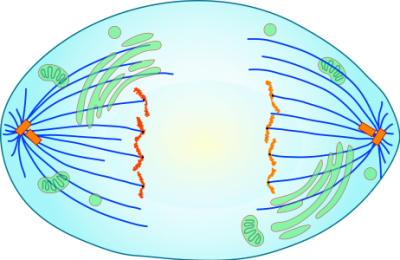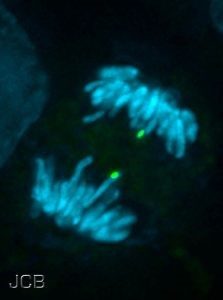Anaphase definition
Anaphase designates one of the sub phases of mitosis and is characterized by the cleavage of centromeres and consequent separation of the two chromatids from each chromosome that moves away to opposite poles of the cell. It is divided into anaphase A and anaphase B.
Cell Cycle
Eukaryotic cells are continually dividing and originating genetically identical daughter cells. In order to do this, cells resort to the process denominated ‘mitosis’, where initially there is duplication of the genetic material and then there is nuclear and cytoplasmic division. Duplication of the genetic material occurs in the cell cycle phase entitled ‘S phase’, which is preceded by G1 phase and succeeded by G2 phase. These three phases make up the interphase. From interphase, the cell cycle progress to M phase, which is characterized by the division of the nucleus and it is organized into prophase, metaphase, anaphase and telophase, and ends with cytokinesis, in which the cytoplasm divides.
Anaphase A
Anaphase A is characterized by the shortening of the kinetochore microtubules.
This phase abruptly begins with the activation of the Anaphase Promoting Complex (APC). APC is a proteolytic complex that inactivates M-CdK (by cleaving Cyclin-M) and activates the cysteine protease Separase (by cleaving the inhibitory protein Securin). Inactivation of M-Cdk makes the progress of cell cycle possible (from metaphase to anaphase). Separase is responsible for the cleavage of the coesin complexes, which have the function of keeping sister chromatids together during the former phase of the cell cycle – metaphase. It is, thus, possible for the cell to separate sister chromatids and make them migrate to opposite poles.
Migration of the chromatids to opposite poles of the cell is only possible due to shortening of kinetochore microtubules and to depolymerisation of interpolar microtubules, and it is dependent on kinetochore motor proteins.
Anaphase B
Anaphase B is characterized by evident spacing of sister chromatids and cell poles (Figures 1 and 2).
This phase is dependent on proteins located at cell poles and motor proteins in central mitotic spindle, which moves the poles away.

Figure 1 – Separated chromatids sisters migrating to opposite cell poles, during anaphase (schematic image).

Figure 2 – Separated chromatids sisters migrating to opposite cell poles, during anaphase (fluorescence microscopy image).
Anaphase entrance control
Cell has several checkpoints that halt cell cycle if it is not occurring correctly. At the end of metaphase (i.e., for entrance into anaphase), there is a checkpoint which confirms that all the sister chromatids are attached to their mitotic spindle microtubules. This checkpoint resort to a negative signal, i.e., any chromatid that is not attached to the mitotic spindle sends a signal to the cell and cell cycle is interrupted by inactivation of APC.
References:
- Alberts B., Johnson A., Lewis J., Raff M., Keith R., Walter P. (2007). Molecular Biology of the Cell (5th edition). Garland Science, New York.
- Cooper G.M. (2000). The Cell: A Molecular Approach (2th edition). Sinauer Associates, Sunderland (MA).
- Lodish H., Berk A., Zipursky S.L., Matsudaira P., Baltimore D., Darnell J. (2000). Molecular Cell Biology (4th edition). W. H. Freeman, New York.




